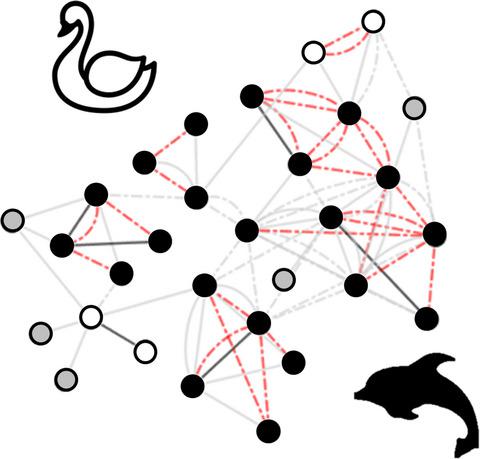当前位置:
X-MOL 学术
›
FEBS Open Bio
›
论文详情
Our official English website, www.x-mol.net, welcomes your feedback! (Note: you will need to create a separate account there.)
Self-selecting peer groups formed within the laboratory environment have a lasting effect on individual student attainment and working practices.
FEBS Open Bio ( IF 2.6 ) Pub Date : 2020-06-07 , DOI: 10.1002/2211-5463.12902 Melissa M Lacey 1 , Susan G Campbell 1 , Holly Shaw 1 , David P Smith 1
FEBS Open Bio ( IF 2.6 ) Pub Date : 2020-06-07 , DOI: 10.1002/2211-5463.12902 Melissa M Lacey 1 , Susan G Campbell 1 , Holly Shaw 1 , David P Smith 1
Affiliation

|
Within the present study, we investigate the lasting effect of laboratory peer group interactions on the end of year attainment of Biosciences and Chemistry students. By asking students to identify who they primarily work with within the laboratory environment and evaluating the interactions through cluster analysis, we identified two main categories of laboratory peer groups: the first long‐lived well‐established pairings of two students, ‘swans’, who work together for all or the majority of the laboratory sessions; and the second dynamic fluid groups, ‘dolphins’, of between three and nine students who work with each other interchangeably. Statistical analysis is presented, which demonstrates that individuals within each laboratory peer group were likely to achieve a similar average mark at the end of the first year of study on the course. We identified the driving factors for the formation of these groups as friendship and perceived work ethic. There is a preference for high‐achieving students to work with other high‐achieving students and lower‐achieving to group around a shared social background. Targeted interventions, in which pairings were selected by the tutor at the onset of the study, altered the ratio from long‐lived pairs to more dynamic groups and increased students’ willingness to work with others outside of their group but did not change the drivers of group formation or resulting pattern of achievement. We conclude with recommendations around group working within the laboratory environment.
中文翻译:

在实验室环境中形成的自选同伴小组对个别学生的成绩和工作实践有持久的影响。
在本研究中,我们调查了实验室同龄人互动对生物科学和化学学生学业年终成绩的持久影响。通过让学生确定他们在实验室环境中主要与谁一起工作并通过聚类分析评估互动,我们确定了实验室同龄人的两大类:两个学生的第一个长期建立的配对,“天鹅”,他们为所有或大部分的实验室课程一起工作;第二个动态流体组“海豚”,由三到九名学生组成,他们可以互换工作。提供了统计分析,这表明每个实验室同龄人组中的个人可能会在课程的第一年学习结束时达到类似的平均分数。我们将形成这些群体的驱动因素确定为友谊和感知的职业道德。成绩优异的学生倾向于与其他成绩优异的学生一起工作,而成绩较差的学生则倾向于围绕共同的社会背景进行分组。有针对性的干预,即由导师在研究开始时选择配对,将比例从长期配对改变为更有活力的群体,并增加了学生与群体以外的其他人合作的意愿,但没有改变群体形成或由此产生的成就模式。我们最后提出了围绕实验室环境中的小组工作的建议。成绩优异的学生倾向于与其他成绩优异的学生一起工作,而成绩较差的学生则倾向于围绕共同的社会背景进行分组。有针对性的干预,即在研究开始时由导师选择配对,改变了从长期配对到更有活力的群体的比例,并增加了学生与团队以外的其他人合作的意愿,但没有改变驱动因素群体形成或由此产生的成就模式。我们最后提出了围绕实验室环境中的小组工作的建议。成绩优异的学生倾向于与其他成绩优异的学生一起工作,而成绩较差的学生则倾向于围绕共同的社会背景进行分组。有针对性的干预,即由导师在研究开始时选择配对,将比例从长期配对改变为更有活力的群体,并增加了学生与群体以外的其他人合作的意愿,但没有改变群体形成或由此产生的成就模式。我们最后提出了围绕实验室环境中的小组工作的建议。将比例从长期配对改变为更有活力的团体,并增加了学生与团体以外的其他人合作的意愿,但并未改变团体形成的驱动因素或由此产生的成就模式。我们最后提出了围绕实验室环境中的小组工作的建议。将比例从长期配对改变为更有活力的团体,并增加了学生与团体以外的其他人合作的意愿,但并没有改变团体形成的驱动因素或由此产生的成就模式。我们最后提出了围绕实验室环境中的小组工作的建议。
更新日期:2020-06-07
中文翻译:

在实验室环境中形成的自选同伴小组对个别学生的成绩和工作实践有持久的影响。
在本研究中,我们调查了实验室同龄人互动对生物科学和化学学生学业年终成绩的持久影响。通过让学生确定他们在实验室环境中主要与谁一起工作并通过聚类分析评估互动,我们确定了实验室同龄人的两大类:两个学生的第一个长期建立的配对,“天鹅”,他们为所有或大部分的实验室课程一起工作;第二个动态流体组“海豚”,由三到九名学生组成,他们可以互换工作。提供了统计分析,这表明每个实验室同龄人组中的个人可能会在课程的第一年学习结束时达到类似的平均分数。我们将形成这些群体的驱动因素确定为友谊和感知的职业道德。成绩优异的学生倾向于与其他成绩优异的学生一起工作,而成绩较差的学生则倾向于围绕共同的社会背景进行分组。有针对性的干预,即由导师在研究开始时选择配对,将比例从长期配对改变为更有活力的群体,并增加了学生与群体以外的其他人合作的意愿,但没有改变群体形成或由此产生的成就模式。我们最后提出了围绕实验室环境中的小组工作的建议。成绩优异的学生倾向于与其他成绩优异的学生一起工作,而成绩较差的学生则倾向于围绕共同的社会背景进行分组。有针对性的干预,即在研究开始时由导师选择配对,改变了从长期配对到更有活力的群体的比例,并增加了学生与团队以外的其他人合作的意愿,但没有改变驱动因素群体形成或由此产生的成就模式。我们最后提出了围绕实验室环境中的小组工作的建议。成绩优异的学生倾向于与其他成绩优异的学生一起工作,而成绩较差的学生则倾向于围绕共同的社会背景进行分组。有针对性的干预,即由导师在研究开始时选择配对,将比例从长期配对改变为更有活力的群体,并增加了学生与群体以外的其他人合作的意愿,但没有改变群体形成或由此产生的成就模式。我们最后提出了围绕实验室环境中的小组工作的建议。将比例从长期配对改变为更有活力的团体,并增加了学生与团体以外的其他人合作的意愿,但并未改变团体形成的驱动因素或由此产生的成就模式。我们最后提出了围绕实验室环境中的小组工作的建议。将比例从长期配对改变为更有活力的团体,并增加了学生与团体以外的其他人合作的意愿,但并没有改变团体形成的驱动因素或由此产生的成就模式。我们最后提出了围绕实验室环境中的小组工作的建议。



























 京公网安备 11010802027423号
京公网安备 11010802027423号